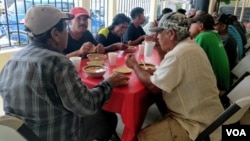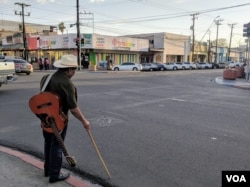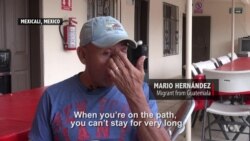Following a lunch of warm menudo (a traditional Mexican soup) and corn tortillas on a gated porch, some of the migrants in Mexicali, Mexico’s Mana Pastoral Center — a shelter for adult men — search for day work. A few hang around.
Many are recent arrivals from the “Northern Triangle” of Guatemala, Honduras or El Salvador, planning to continue their migration north in an escape from gang-related violence and extreme poverty. Others have been in Mexicali for weeks, unable to pay a smuggler to help them cross the border into the U.S.
Honduran-native Elmer García has made it across before, twice, and was deported as many times. But after staring death in the face on his third attempt, he has reached his limit.
“Since God gave me another opportunity to live, I would prefer to work here and help my kids,” he told VOA.
García recounts his kidnapping in Mexico, some 25 kilometers from the U.S. border; a meticulously planned attack, he is convinced, coordinated among his smugglers and gunmen waiting at the top of a mountain.
“They said they would kill us,” he said, recounting the feel of a gun at his temple. “They asked for our families’ phone numbers and began to call them.”
García’s harrowing experience is not uncommon in Mexico, where gangs and organized crime groups control common routes among Central America’s most vulnerable migrants, threatening travelers with extortion, kidnapping and violence.
Weighing the risks
But for the more fortunate families, many who have escaped with their lives aboard the country’s infamous cargo train, known as “La Bestia,” a central question remains: if the U.S. is inhospitable, how safe is it to remain in the country?
Migrants and refugees who settle in Mexico face significant barriers, including “acute risks of kidnapping, disappearance, sexual assault, trafficking, and other grave harms” according to a 2017 report by the nonprofit Human Rights First.
But if U.S. President Donald Trump’s administration has its way, Mexico would become a “safe third country,” a status laid out in a 2002 agreement between the U.S. and Canada. In the pact, both countries are deemed safe for refugee claimants, who are “required to request refugee protection in the first safe country they arrive in,” with few exceptions.
Back in April, while a “caravan” of Central American migrants was making its way to the U.S.-Mexico border, U.S. Department of Homeland Security Secretary Kirstjen Nielsen released a statement echoing the U.S.-Canada agreement.
“DHS encourages persons with asylum or other similar claims to seek protections in the first safe country they enter, including Mexico,” the statement read.
WATCH: La Bestia routes:
But any prospect for change in bilateral policy rests on Mexico’s July 1 presidential election. Leftist frontrunner Andrés Manuel López Obrador, of the National Regeneration Movement (MORENA), has indicated he will be a strong human rights defender for all migrants, including those who, “out of necessity, must abandon their towns to find life in the United States.”
Since 1990, Mexico has discernibly changed regarding immigrants. Over a 27-year span, it experienced one of the world’s largest increases in its diaspora population — an estimated 8.6 million, according to the New York Times. Among asylum-seekers, the country saw more than a six-fold increase in total requests between 2013 and 2016.
But the human rights organization, Washington Office on Latin America (WOLA), advocates against a “safe third country” agreement, citing a report that indicates 99 percent of crimes against migrants in Mexico remain uninvestigated.
“Abuses and crimes against migrants are very common, sadly,” Ximena Suárez-Enríquez, WOLA’s Assistant Director for Mexico, told VOA.
She lists kidnappings, robbery and threats from some Mexican officials as common, along with extortion, and maintains the Mexican government is ill-equipped to process more asylum applications.
“If more people are denied asylum in the U.S. because they are fleeing violence, that will increase the number of asylum petitions in Mexico, and in that sense it will create a problem for Mexican authorities,” Suárez-Enríquez said.
‘Mexico has supported us’
At Mexicali’s Albergue del Desierto, or Shelter of the Desert, director Mónica Oropeza Rodríguez notes that migrants who travel on La Bestia’s shorter routes — along the Gulf or through Central Mexico often encounter a more dangerous border than in Baja California. But that doesn’t mean Western-bound migrants experience a safe journey.
“A young man once told me … ‘Do you remember the scariest horror movie you’ve ever seen? Triple that, is what I experienced to get here,’” Oropeza Rodríguez said.
“We have high indices of corruption,” she continued. “My own population of Mexico is trying to cross and seek asylum in the United States because of the risks and [lack of] security in their communities.”
WATCH: Migrants on harrowing trip before reaching Mexico
But Mario Hernández, a migrant from Guatemala who lost two children at the hands of the Maras gang, breathes a cautious sigh that the worst is behind him, now that he is off “the path” where he says he was assaulted and robbed by police.
Instead of chancing asylum in the U.S. — “a place where they don’t want you” — he has opted to stay and find work in Mexicali instead.
“It’s on the border and many people say there’s work here … it’s supposedly the most calm,” Hernández said.
“The truth is, Mexico has supported us,” he continued, in defense of his decision.
“Mexico has given me food, Mexico has given me a roof … I’m not hungry, thank God.”
VOA Spanish service reporter Arturo Martinez contributed to this report.












